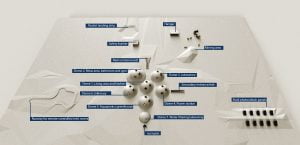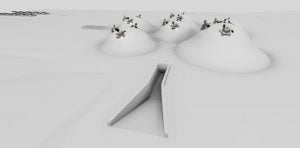Moon Camp Pioneers Gallery 2020-2021
In Moon Camp Pioneers each team’s mission is to 3D design a complete Moon Camp using Fusion 360. They also have to explain how they will use local resources, protect astronauts from the dangerous of space and describe the living and working facilities.
Team: SIXTH-SEA
artistic high school “dosso dossi” ferrara Italy 18, 19
External viewer for 3d project
|
Project description
Our project involves the construction of 6 circular basement rooms surmounted by domes, radially arranged around a central dome and connected by underground corridors. The modules provided are divided into separate rooms with di erent functions: Dome 1: living area and kitchen Dome 2: relax area, bathrooms and gym Dome 3: laboratory Dome 4: power station Dome 5: greenhouse Dome 6: infirmary Dome 7: water filtering laboratory Considering the isolation and extreme living conditions, we are planning a special recreational activity: creating remote controlled mini-rovers for competition and testing them on a circuit outside the base, this activity will also help to understand the locomotion skills on lunar soil to improve the ability to move around on the regolith as well as o ering a playful moment for the astronauts. |
|||
|
Where do you want to build your Moon Camp?
The base is planned to be built at the South Pole near the Shackleton crater, since the analysis carried out by the “lunar prospector” and “kaguya” probes revealed excellent conditions for both solar radiation ideal for photovoltaic systems and continuous energy production. Moreover, the interior of the crater is permanently shaded, which will allow the presence of large quantities of water in the solid state. How do you plan to build your Moon Camp? Describe the techniques and materials you would use.
The first inner layer made of aluminium foam panels sealed together, a structural layer made of regolith and sulphur modules printed in 3D through solar printers, then a final protective layer made through the accumulation of lunar soil dust. The connecting parts between the elements will be made on Earth and then transported and assembled. All the transparent parts will be made with triple layers of glass and protection systems, and will be assembled on Earth, brought to the moon and inserted into their accommodations. The environment on the Moon is very dangerous for the astronauts. Explain how your Moon Camp will protect them.
Technological choices and the layer of lunar soil make it possible to protect the environments from micro-meteorites through the outer layer of dust which cushions impacts, while radiation is absorbed by the other internal layers of the structure. Explain how your Moon Camp will provide the astronauts with:
|
|||
|
Water
|
Food
|
Electricity
|
Air
|
|
The water system is composed of a 5000 litre tank with a pump which pushes the water through pipes to the taps, and the used water is collected in a 2000 litre return tank, purified and returned to the first tank. |
Food will mainly be provided by the greenhouse, which is expected to produce food such as fruit and vegetables, such as tomatoes, lettuce and |
Dome 4, containing the power station, includes batteries and accumulators, one for use and the other for storage, an inverter to receive power from the photovoltaic field, a hydrogen power generator, the general electric panel, a computer to manage the system: lights, sockets, oxygenation, greenhouse, etc. |
A system of (electrolytic) water splitting will make it possible to obtain hydrogen and oxygen to be used for ventilation and energy production in the air system, consisting of: 3000 l of oxygen in cylinders, brought in from the Earth, ice and plants, an air pump and pipes. |
|
Explain what would be the main purpose of your Moon Camp (for example: commercial, scientific, and/or tourist purposes).
Our moon camp will host 5 researchers, who will go there for scientific purposes, but given the explorations and possible discoveries of materials, our base will also be developed for commercial/tourist purposes. It is also hypothesised the realization of a dedicated environment will be set up to study the adaptability of small farm and laboratory animals. The process will initially be experimental, and later it will be possible to move on to the phase for food or commercial purposes. |
|||
|
Describe a day on the Moon for your Moon Camp astronaut crew.
The base will be operational 24 hours a day and there will have to be monitoring and working shifts. The operation of the base is guaranteed by a system of alternating shifts: morning, afternoon, night and rest. In a typical day of the inhabitants of the base in their morning shift 8-16 we can predict that: They will start with an energetic breakfast, after that they will take an excursion to the moon, extract materials from the lunar soil, useful for research studies, they will also try to discover and map the soil surrounding the base. They will then spend time to the maintenance of the plants and dedicate to the breeding of the animals. They will later have to contact the base to inform them of any new findings from their research. At the end of their shift, there will be motor activities in the gym to compensate for the di culties of a low-gravity environment. There will be time for them to take care of themselves and their hygiene; they will wash, rest and change their clothes. They will also be able to connect with their families, friends, or contact the Earth base. Together they will prepare a hearty lunch, which will help them get through the rest of the day. Relaxed and full, they will devote themselves to intense hours of study and research in their laboratory, where they can examine materials and observe the stars. At the end of the working day, they will make a video collection of their daily discoveries (a kind of video diary, we can intend it as promoting and disseminating the experience and the results of the experiments). Around evening, they will have to attend their usual de-briefing, to receive instructions on their mission, get assigned the next day’s tasks and report on the status of the base. Some days will be dedicated to the mini-rover activity. At this point in the day, our astronauts will start preparing dinner with music in a relaxed and cheerful atmosphere. The end of the day will be spent watching a film in their spacious living room, or taking a walk under the stars. They will go to bed, ready to start another busy day the next morning. |
|||








